 |
|
CADORE
From Cortina as you descend in to the Ampezzo valley
you can't miss the pyramidal Antelao towering above as you come to San
Vito, a pretty village resort that has successfully blended its traditions
with a stylishly modern square. If Antelao is the highest peak in the
valley, it is admirably complemented by Mount Pelmo opposite: with its
saddle-like summit, Pelmo is also known as 'God's Throne'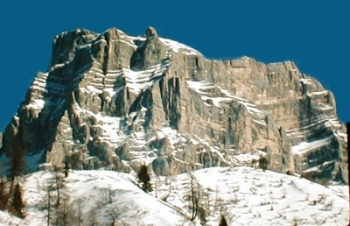 .
Many fossils have been found on its flanks, along with the footprints
of the dinosaurs that roamed here hundreds of thousands of years ago.
In quick succession are the resorts of Borca, Vodo, Valle and Tai, followed
by the village of Pieve. This is the heart of Cadore.
.
Many fossils have been found on its flanks, along with the footprints
of the dinosaurs that roamed here hundreds of thousands of years ago.
In quick succession are the resorts of Borca, Vodo, Valle and Tai, followed
by the village of Pieve. This is the heart of Cadore.
ART AND CULTURE
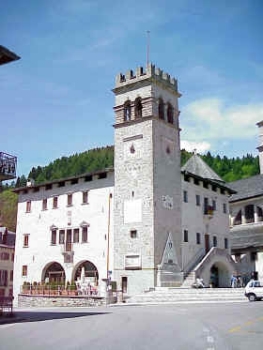 Many
remarkable monuments can be admired in the municipal territory, a testimony
to the important role played by Pieve within the community of Cadore. A
political and administrative centre for the entire area of Cadore, the Palazzo
della Magnifica ComunitÓ (Palace of the Magnificent Community) was built
between 1447 and 1477; the Tower, erected a few decades later, dates back
to 1491. Following its destruction in the early sixteenth century by a serious
fire started during a raid on the village by troops of the League of Cambrai,
the Palace was entirely reconstructed: its facade is sober, with simple
and severe lines; in its interior, the ample and majestic Hall of the Community
is magnificently decorated, with works of art, trophies, busts of Cadore
natives who had been valorous patriots, and the coat of arms of the Magnificent
Community (which bears the motto "Justitia et fide conservabitur"). Meetings
of the Magnificent Community are still today held in the Palace; it houses
a museum and, throughout the years, hosts conventions and events. A religious
centre and ancient main parish church of many Cadore churches, the present
church of Pieve, is named after Santa Maria Nascente. The parish is of ancient
origins but the church we can today admire is fairly recent: it was in fact
built over a pre-existing Gothic edifice between 1761 and 1819 and underwent
subsequent restructuring work.
Many
remarkable monuments can be admired in the municipal territory, a testimony
to the important role played by Pieve within the community of Cadore. A
political and administrative centre for the entire area of Cadore, the Palazzo
della Magnifica ComunitÓ (Palace of the Magnificent Community) was built
between 1447 and 1477; the Tower, erected a few decades later, dates back
to 1491. Following its destruction in the early sixteenth century by a serious
fire started during a raid on the village by troops of the League of Cambrai,
the Palace was entirely reconstructed: its facade is sober, with simple
and severe lines; in its interior, the ample and majestic Hall of the Community
is magnificently decorated, with works of art, trophies, busts of Cadore
natives who had been valorous patriots, and the coat of arms of the Magnificent
Community (which bears the motto "Justitia et fide conservabitur"). Meetings
of the Magnificent Community are still today held in the Palace; it houses
a museum and, throughout the years, hosts conventions and events. A religious
centre and ancient main parish church of many Cadore churches, the present
church of Pieve, is named after Santa Maria Nascente. The parish is of ancient
origins but the church we can today admire is fairly recent: it was in fact
built over a pre-existing Gothic edifice between 1761 and 1819 and underwent
subsequent restructuring work.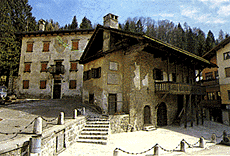 The interior preserves numerous works of art by Tiziano, Cesare, Francesco
and Orazio Vecellio, Tizianello, Giovan Battista Cima da Conegliano and
many others. Also of interest are the church of Christ of Valcalda and the
church dedicated to the SS.Angeli: the former is of very ancient origin
and was once dedicated to Sant'Antonio Abate. The church is officiated by
the Carmelite Barefoot Fathers, who live in the adjacent convent. At Nebbiu,
the beautiful parish church dedicated to Saint Bartholomew the Apostle is
worth a visit. It preserves a few valuable works of art, among which the
two altarpieces by Carlo Capobianco and the one by Marco Vecellio and Giuseppe
Cherubin are outstanding. In Pozzale we find the church of Saint Thomas
the Apostle: inside there is a precious polyptych by Vittore Carpaccio.
Besides proudly preserving some of his works, Pieve has honoured its own
most illustrious son, Tiziano Vecellio, by dedicating a monument to him
and conserving his natal house, an ancient and dignified construction not
far from the main square.
The interior preserves numerous works of art by Tiziano, Cesare, Francesco
and Orazio Vecellio, Tizianello, Giovan Battista Cima da Conegliano and
many others. Also of interest are the church of Christ of Valcalda and the
church dedicated to the SS.Angeli: the former is of very ancient origin
and was once dedicated to Sant'Antonio Abate. The church is officiated by
the Carmelite Barefoot Fathers, who live in the adjacent convent. At Nebbiu,
the beautiful parish church dedicated to Saint Bartholomew the Apostle is
worth a visit. It preserves a few valuable works of art, among which the
two altarpieces by Carlo Capobianco and the one by Marco Vecellio and Giuseppe
Cherubin are outstanding. In Pozzale we find the church of Saint Thomas
the Apostle: inside there is a precious polyptych by Vittore Carpaccio.
Besides proudly preserving some of his works, Pieve has honoured its own
most illustrious son, Tiziano Vecellio, by dedicating a monument to him
and conserving his natal house, an ancient and dignified construction not
far from the main square.
TITIAN (Tiziano Vecellio)
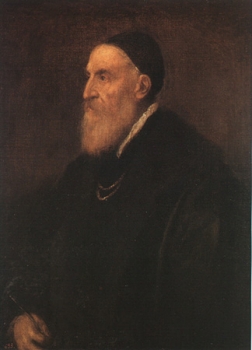 One
of the most important artistic figures of the 16th century was born in
Pieve di Cadore in 1490. He trained mainly in Venice, where he produced
most of the works that today can be observed in famous museums around
the world. Titian's legacy to his land was the profound influence on the
style of many local artists. The Vecellios were an ancient noble family
of Cadore with feudal privileges during the Middle Ages, later confirmed
by the rule of the Serenissima; many of its members were notaries and
held public positions. Tiziano was born in Pieve at the end of the fifteenth
century, probably in 1490, and, together with his older brother Francesco,
started studying drawing and painting: he was sent to Venice to stay with
relatives: he became a pupil of Giorgione and came into contact with the
artists that worked during those years in the lagoon city, treasuring
their examples and precious teachings, and very soon surpassing them thanks
to his eminent capacities. Within a short time he became famous and venerated,
and spent his life between Venice and the main European courts, dying
in Venice in 1576. The house he was born in is now a tiny museum for savouring
past times and appreciating something of the artist's genius. An original
painting is in the parish church.
One
of the most important artistic figures of the 16th century was born in
Pieve di Cadore in 1490. He trained mainly in Venice, where he produced
most of the works that today can be observed in famous museums around
the world. Titian's legacy to his land was the profound influence on the
style of many local artists. The Vecellios were an ancient noble family
of Cadore with feudal privileges during the Middle Ages, later confirmed
by the rule of the Serenissima; many of its members were notaries and
held public positions. Tiziano was born in Pieve at the end of the fifteenth
century, probably in 1490, and, together with his older brother Francesco,
started studying drawing and painting: he was sent to Venice to stay with
relatives: he became a pupil of Giorgione and came into contact with the
artists that worked during those years in the lagoon city, treasuring
their examples and precious teachings, and very soon surpassing them thanks
to his eminent capacities. Within a short time he became famous and venerated,
and spent his life between Venice and the main European courts, dying
in Venice in 1576. The house he was born in is now a tiny museum for savouring
past times and appreciating something of the artist's genius. An original
painting is in the parish church.
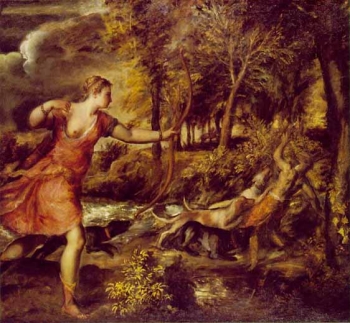
Authors: Carlo |
Around Venice |
Venise et ses alentours |
Home page Site |